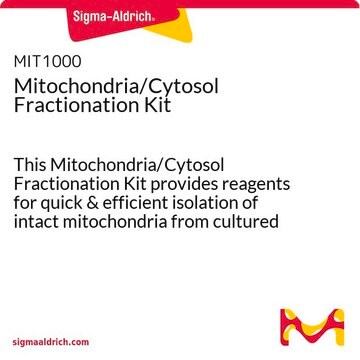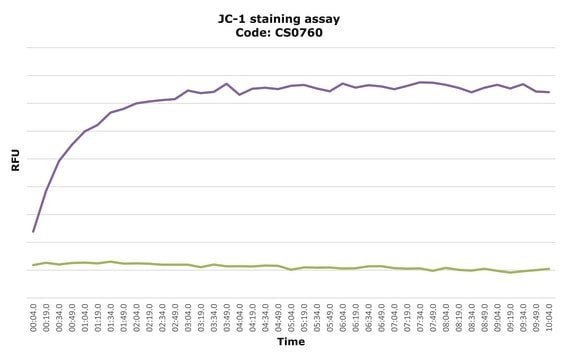MITOISO3
Yeast Mitochondria Isolation Kit
sufficient for 40 applications (using 20 OD culture preparations), isolation of an enriched mitochondrial fraction from yeast cells
Sign Into View Organizational & Contract Pricing
All Photos(1)
About This Item
UNSPSC Code:
12352200
NACRES:
NA.32
Recommended Products
Quality Level
usage
sufficient for 40 applications (using 20 OD culture preparations)
storage temp.
−20°C
General description
Mitochondria, the site of most of the energy production in eukaryotic cells, are characterized by a double membrane structure, an outer membrane and folded inner membrane. Isolated mitochondria may be used as tools for in vitro studies such as respiration and energy production studies, apoptosis, mtDNA and mtRNA, and mitochondrial protein profiling.
Application
The kit contains all the reagents required for yeast cell wall lysis by lyticase (spheroplast formation) followed by cell membrane lysis/breakage and mitochondria isolation. In addition, the kit includes an extraction buffer for mitochondrial protein profiling to be used in proteome studies and a storage buffer for use with intact mitochondria. Yeast Mitochondria Isolation Kit has been used in the isolation and extraction of mitochondria.
Features and Benefits
• The kit′s features include speed, sensitivity, ease of use, and specificity
• The kit contains all the reagents required for a fast and easy yeast cell wall lysis by lyticase (spheroplast formation) followed by cell membrane lysis/breakage and mitochondria isolation
• The kit provides two alternatives for cell membrane disruption. The first one by a detergent and second one by homogenization.
• The kit includes an extraction buffer for mitochondrial protein profiling to be used in proteome studies
• The kit includes a storage buffer for use with intact mitochondria.
• The reagents are sufficient for 40 procedures using 20 OD culture preparations
• The kit was tested on Saccharomyces cerevisiae, Pichia pastoris, and Schizosaccharomyces pombe
• The kit contains all the reagents required for a fast and easy yeast cell wall lysis by lyticase (spheroplast formation) followed by cell membrane lysis/breakage and mitochondria isolation
• The kit provides two alternatives for cell membrane disruption. The first one by a detergent and second one by homogenization.
• The kit includes an extraction buffer for mitochondrial protein profiling to be used in proteome studies
• The kit includes a storage buffer for use with intact mitochondria.
• The reagents are sufficient for 40 procedures using 20 OD culture preparations
• The kit was tested on Saccharomyces cerevisiae, Pichia pastoris, and Schizosaccharomyces pombe
Kit Components Also Available Separately
Product No.
Description
SDS
related product
Product No.
Description
Pricing
Signal Word
Danger
Hazard Statements
Precautionary Statements
Hazard Classifications
Acute Tox. 4 Oral - Aquatic Acute 1 - Aquatic Chronic 1 - Carc. 2 - Eye Dam. 1 - Repr. 2 - Resp. Sens. 1 - Skin Irrit. 2 - STOT RE 2
Storage Class Code
10 - Combustible liquids
Certificates of Analysis (COA)
Search for Certificates of Analysis (COA) by entering the products Lot/Batch Number. Lot and Batch Numbers can be found on a product’s label following the words ‘Lot’ or ‘Batch’.
Already Own This Product?
Find documentation for the products that you have recently purchased in the Document Library.
Customers Also Viewed
Yeast cells expressing the human mitochondrial DNA polymerase reveal correlations between polymerase fidelity and human disease progression
Qian Y, et al.
The Journal of Biological Chemistry (2017)
Christian Streng et al.
The EMBO journal, 40(17), e108083-e108083 (2021-07-14)
Mitochondria are essential organelles because of their function in energy conservation. Here, we show an involvement of mitochondria in phytochrome-dependent light sensing in fungi. Phytochrome photoreceptors are found in plants, bacteria, and fungi and contain a linear, heme-derived tetrapyrrole as
Erika Steele et al.
Microbial cell factories, 20(1), 138-138 (2021-07-21)
Myo-Inositol Phosphate Synthase (MIP) catalyzes the conversion of glucose 6- phosphate into inositol phosphate, an essential nutrient and cell signaling molecule. Data obtained, first in bovine brain and later in plants, established MIP expression in organelles and in extracellular environments.
Panos Oikonomou et al.
Proceedings of the National Academy of Sciences of the United States of America, 117(43), 26710-26718 (2020-10-11)
Large-scale proteomic methods are essential for the functional characterization of proteins in their native cellular context. However, proteomics has lagged far behind genomic approaches in scalability, standardization, and cost. Here, we introduce in vivo mRNA display, a technology that converts
María Guirola et al.
The Biochemical journal, 432(3), 595-605 (2010-09-23)
The Saccharomyces cerevisiae gene PIF1 encodes a conserved eukaryotic DNA helicase required for both mitochondrial and nuclear DNA integrity. Our previous work revealed that a pif1Δ strain is tolerant to zinc overload. In the present study we demonstrate that this
Our team of scientists has experience in all areas of research including Life Science, Material Science, Chemical Synthesis, Chromatography, Analytical and many others.
Contact Technical Service










